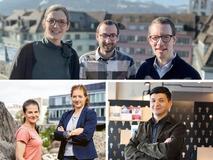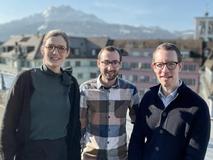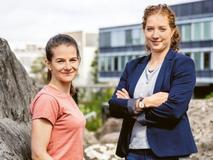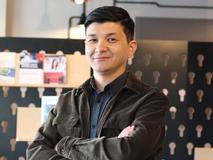CHF 40,000 for microalgae photosynthesis to capture CO2, the production of whole cut cultivated meat, and a novel CO2 and flue gas capture system
15.05.2023
Arrhenius, sallea, and SEPARATIC win Venture Kick's second stage of financial and entrepreneurial support. Their projects aim to develop and operate large-scale bioreactors in large numbers for the production of microalgae where the carbon will be stored geologically; allow the manufacturing of novel cell-growth scaffolds resulting in whole-cut cultivated meat indistinguishable from a real steak; and develop a novel membrane design where adsorbent material is incorporated into the membrane for CO2 and flue gas capture.
 |
 Arrhenius: on the left, CFO, CBDO and CMO Karina von dem Berge, in the middle CEO and CTO Reto Tamburini, and on the right CSO Dr. Mirko Kleingries.
|
 sallea:CTO Dr. Nicole Kleger, on the left and CEO Simona Fehlmann, on the right Photocredits © ETH Foundation / Daniel Winkler
|
 SEPARATIC Founder Dr. Timur Ashirov
|
Arrhenius: microalgae photosynthesis to capture CO2
In order to counteract climate change, not only must new CO2 emissions be prevented, but historical emissions also have to be removed from the atmosphere permanently on a large scale. A promising approach for atmospheric CO2 removal is the production and long-term storage of biomass. The most efficient way to produce biomass is the production of rapidly dividing microalgae in warm water.
Arrhenius aims to develop and operate large-scale bioreactors in large numbers for the production of microalgae where the carbon will be stored geologically. The team is composed of CEO and CTO Reto Tamburini, MScE and actually, a Research Associate at HSLU in the field of Negative Emission Technology (NET) and microalgae cultivation specialist; CFO, CBDO, CMO Karina von dem Berge, MScBA; CSO Dr. Mirko Kleingries, Ph.D.; and serial entrepreneur Wilm Kleingries, GradEng, in the supervisory board. Arrhenius aims to offer Carbon Dioxide Removal as a Service (CDRaaS) to companies and private individuals as well as to give climate cooperatives the opportunity to clean the atmosphere through citizen participation by providing facilities. Arrhenius develops and operates photobioreactors in which microalgae proliferate with unparalleled productivity by supplying water, atmospheric CO2, and nutrients. The carbon of the continuously produced biomass is stored geologically. This two-step process corresponds to a sustainable biotechnological Negative Emission Technology (NET) that offers Carbon offset and Carbon Dioxide Removal as a Service to companies, institutions, and private consumers. The latter is to be achieved through the sale of carbon credits. The Taskforce on Scaling Voluntary Carbon Markets (TSVCM) expects that the market for carbon credits may amount to as much as 2 gigatons of CO2 by 2030. Depending on the CO2 price, this market will exceed the oil market in 2030. The market volume for 2050 is estimated at USD 22 trillion. The Arrhenius USP is their efficient and robust low-tech solution where, as opposed to the competitors, the largest part of the CO2 molecule is already released directly during carbon sequestration as O2 and the carbon is already present in the product as a solid.
The Venture Kick funding will enable the realization of the two prototypes HEP and HPP (MS 1 and 2), which should be completed by fall 2023.
sallea: enabling the production of whole-cut cultivated meat
Producing enough food for a growing world population while reducing environmental damage is a huge challenge. The cultivation of meat has great potential to reduce the use of energy, water, and land. Currently, only the production of thin layers of cultivated meat is possible, which limits the offering to minced or processed meat. To cultivate whole-cut meat, the development of novel cell-growth scaffolds is essential.
sallea's technology enables the manufacturing of such scaffolds addressing the limitations of current systems such as limited cell migration and material freedom. Sallea co-founders CEO Simona Fehlmann, MSc ETH materials science, and CTO Dr. Nicole Kleger, Ph.D. ETH materials science, aim to provide these novel scaffolds to foodtech companies. sallea’s flexible scaffold manufacturing technology holds the potential to enable the cultivation of whole-cut meat indistinguishable from a real steak. The scaffolds are available from a broad range of materials, including edible alginate and cellulose, with high control of the pore shape and size, and overall porosity. The resulting design freedom shall result in highly efficient scaffolds for companies producing cultivated protein like meat and fish. Lab-cultured meat claimed a market size of USD 1.64 M with an estimated compound annual growth rate of 95.8% per year (2022–2030) to reach USD 2.8 billion per year by 2030 (Allied Market Research). Therefore, sallea sees great potential for their technology to further support the highly innovative and fast-moving cellular agriculture field.
The Venture Kick funds will be used to advance the business development at sallea by setting up a clear pathway toward a first pilot project with an industrial collaborator. Further, the funds will be used to complete the proof-of-concept cell test results needed for further non-dilutive funding.
SEPARATIC: a novel CO2 and flue gas capture system direct from the air
The CO2 levels in the atmosphere require massive reductions in current emissions as well as capturing of CO2 that has already been released. Current existing technologies either have high installation costs and require enormous energy to operate making them not widely applicable. Companies and countries are exceeding their carbon limit and often have to invest in carbon capture technologies as a penalty. However, there is no feasible solution that can be applied in the long term. There is an urgent need for systems that can remove CO2 from air and emissions sources effectively and cheaply.
SEPARATIC's team is composed of founder and team leader Timur Ashirov, Ph.D., founder Prof. Ali Coskun, financial analyst, market research and customer relations Vincent Racciatti, MSc., and tech development Olivier Graber, MSE. Together, they have developed a novel membrane design incorporating adsorbent material into the membrane. One of the gases in the mixture will interact with an adsorbent and stick to it while the other one(s) will pass through. This design can be used for direct capture of CO2 and flue gas from the air. They already tested this concept on the lab scale and have obtained initial successful results. The idea is to put these membranes in a module in series and run air through. CO2 in the air will stick to the adsorbent material while N2 and O2 will pass freely. After capacity has been reached, the CO2 can be released back by simple heating under a vacuum and membranes can be reused again. Moreover, captured CO2 can possess an additional value as it will have high purity and can be sold/reused. Current capture technologies are based on adsorbents and require pressurization and huge investment costs for the building of a plant. Other systems that can also capture CO2 from the air such as Climeworks' ones. These are massive and require also multiple steps in the process by using massive amounts of energy. SEPARATIC's USP is that their systems are mobile, without a required plant. They can capture selectively CO2 (high purity), units are reusable, and their tech does not require advanced assembling and maintenance.
The Venture Kick funds will be used for the prototyping of the membrane units. Initially, the membrane unit will be designed to accommodate 20-50 units that are arranged in series, then, it will be fabricated and put to a test in terms of stability, operational lifetime, operational costs, and capture capacity.
In order to counteract climate change, not only must new CO2 emissions be prevented, but historical emissions also have to be removed from the atmosphere permanently on a large scale. A promising approach for atmospheric CO2 removal is the production and long-term storage of biomass. The most efficient way to produce biomass is the production of rapidly dividing microalgae in warm water.
Arrhenius aims to develop and operate large-scale bioreactors in large numbers for the production of microalgae where the carbon will be stored geologically. The team is composed of CEO and CTO Reto Tamburini, MScE and actually, a Research Associate at HSLU in the field of Negative Emission Technology (NET) and microalgae cultivation specialist; CFO, CBDO, CMO Karina von dem Berge, MScBA; CSO Dr. Mirko Kleingries, Ph.D.; and serial entrepreneur Wilm Kleingries, GradEng, in the supervisory board. Arrhenius aims to offer Carbon Dioxide Removal as a Service (CDRaaS) to companies and private individuals as well as to give climate cooperatives the opportunity to clean the atmosphere through citizen participation by providing facilities. Arrhenius develops and operates photobioreactors in which microalgae proliferate with unparalleled productivity by supplying water, atmospheric CO2, and nutrients. The carbon of the continuously produced biomass is stored geologically. This two-step process corresponds to a sustainable biotechnological Negative Emission Technology (NET) that offers Carbon offset and Carbon Dioxide Removal as a Service to companies, institutions, and private consumers. The latter is to be achieved through the sale of carbon credits. The Taskforce on Scaling Voluntary Carbon Markets (TSVCM) expects that the market for carbon credits may amount to as much as 2 gigatons of CO2 by 2030. Depending on the CO2 price, this market will exceed the oil market in 2030. The market volume for 2050 is estimated at USD 22 trillion. The Arrhenius USP is their efficient and robust low-tech solution where, as opposed to the competitors, the largest part of the CO2 molecule is already released directly during carbon sequestration as O2 and the carbon is already present in the product as a solid.
The Venture Kick funding will enable the realization of the two prototypes HEP and HPP (MS 1 and 2), which should be completed by fall 2023.
sallea: enabling the production of whole-cut cultivated meat
Producing enough food for a growing world population while reducing environmental damage is a huge challenge. The cultivation of meat has great potential to reduce the use of energy, water, and land. Currently, only the production of thin layers of cultivated meat is possible, which limits the offering to minced or processed meat. To cultivate whole-cut meat, the development of novel cell-growth scaffolds is essential.
sallea's technology enables the manufacturing of such scaffolds addressing the limitations of current systems such as limited cell migration and material freedom. Sallea co-founders CEO Simona Fehlmann, MSc ETH materials science, and CTO Dr. Nicole Kleger, Ph.D. ETH materials science, aim to provide these novel scaffolds to foodtech companies. sallea’s flexible scaffold manufacturing technology holds the potential to enable the cultivation of whole-cut meat indistinguishable from a real steak. The scaffolds are available from a broad range of materials, including edible alginate and cellulose, with high control of the pore shape and size, and overall porosity. The resulting design freedom shall result in highly efficient scaffolds for companies producing cultivated protein like meat and fish. Lab-cultured meat claimed a market size of USD 1.64 M with an estimated compound annual growth rate of 95.8% per year (2022–2030) to reach USD 2.8 billion per year by 2030 (Allied Market Research). Therefore, sallea sees great potential for their technology to further support the highly innovative and fast-moving cellular agriculture field.
The Venture Kick funds will be used to advance the business development at sallea by setting up a clear pathway toward a first pilot project with an industrial collaborator. Further, the funds will be used to complete the proof-of-concept cell test results needed for further non-dilutive funding.
SEPARATIC: a novel CO2 and flue gas capture system direct from the air
The CO2 levels in the atmosphere require massive reductions in current emissions as well as capturing of CO2 that has already been released. Current existing technologies either have high installation costs and require enormous energy to operate making them not widely applicable. Companies and countries are exceeding their carbon limit and often have to invest in carbon capture technologies as a penalty. However, there is no feasible solution that can be applied in the long term. There is an urgent need for systems that can remove CO2 from air and emissions sources effectively and cheaply.
SEPARATIC's team is composed of founder and team leader Timur Ashirov, Ph.D., founder Prof. Ali Coskun, financial analyst, market research and customer relations Vincent Racciatti, MSc., and tech development Olivier Graber, MSE. Together, they have developed a novel membrane design incorporating adsorbent material into the membrane. One of the gases in the mixture will interact with an adsorbent and stick to it while the other one(s) will pass through. This design can be used for direct capture of CO2 and flue gas from the air. They already tested this concept on the lab scale and have obtained initial successful results. The idea is to put these membranes in a module in series and run air through. CO2 in the air will stick to the adsorbent material while N2 and O2 will pass freely. After capacity has been reached, the CO2 can be released back by simple heating under a vacuum and membranes can be reused again. Moreover, captured CO2 can possess an additional value as it will have high purity and can be sold/reused. Current capture technologies are based on adsorbents and require pressurization and huge investment costs for the building of a plant. Other systems that can also capture CO2 from the air such as Climeworks' ones. These are massive and require also multiple steps in the process by using massive amounts of energy. SEPARATIC's USP is that their systems are mobile, without a required plant. They can capture selectively CO2 (high purity), units are reusable, and their tech does not require advanced assembling and maintenance.
The Venture Kick funds will be used for the prototyping of the membrane units. Initially, the membrane unit will be designed to accommodate 20-50 units that are arranged in series, then, it will be fabricated and put to a test in terms of stability, operational lifetime, operational costs, and capture capacity.


